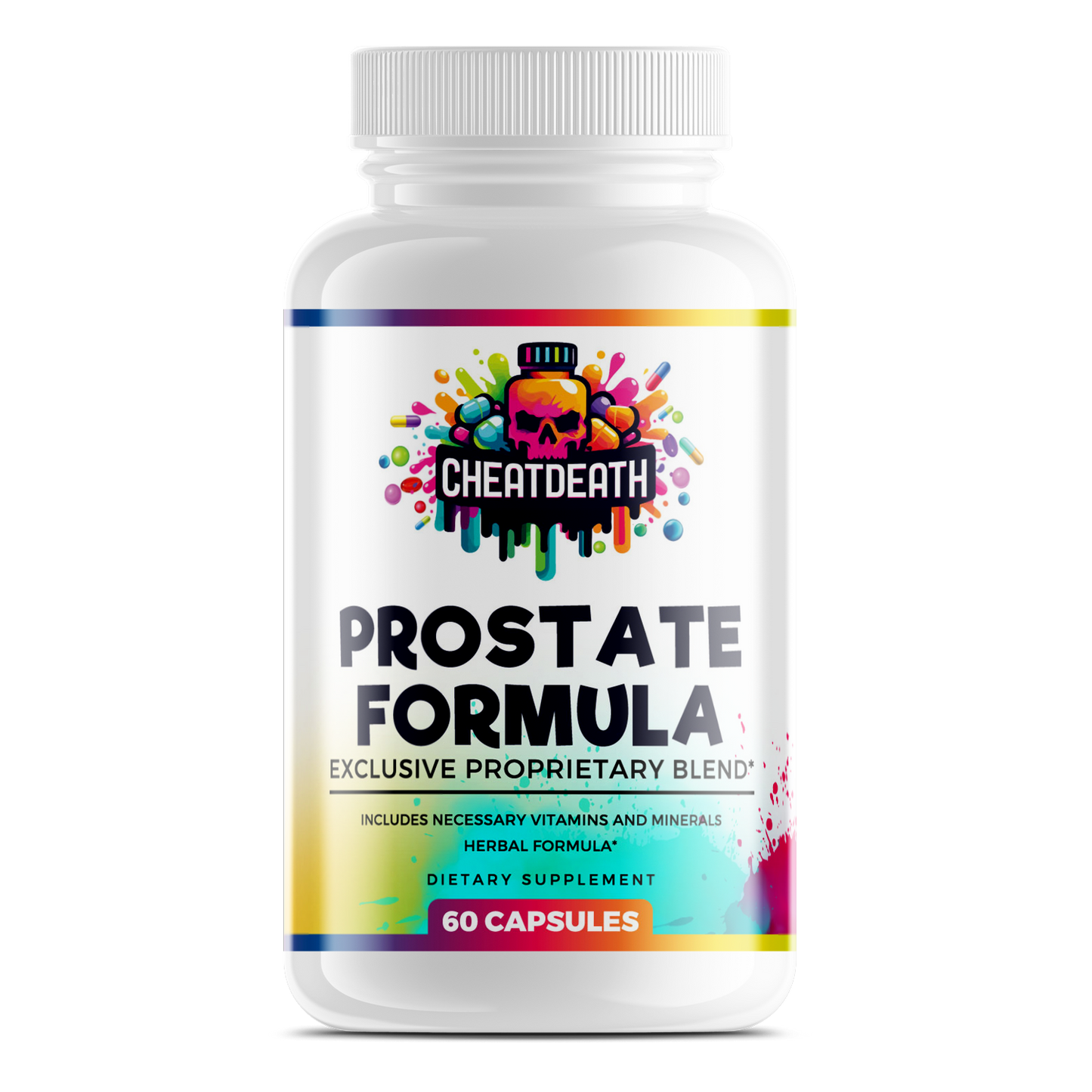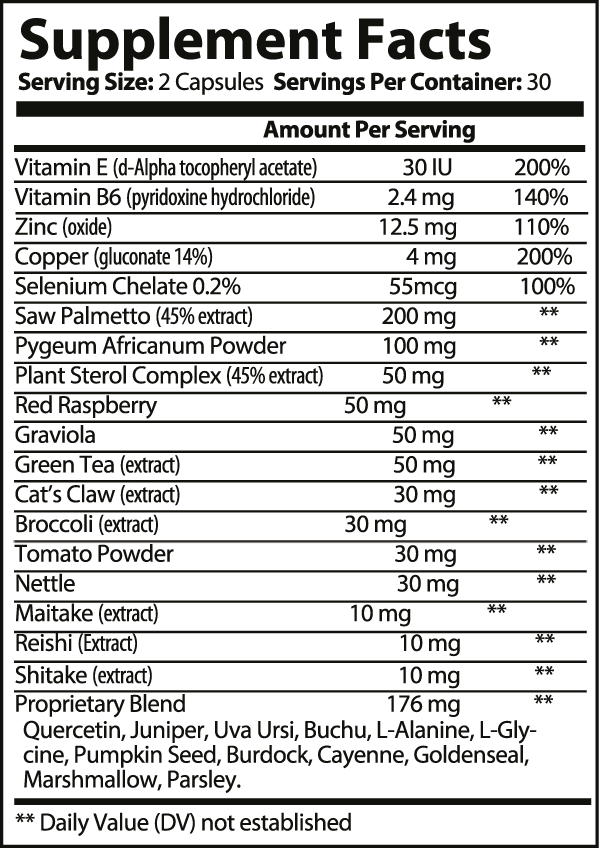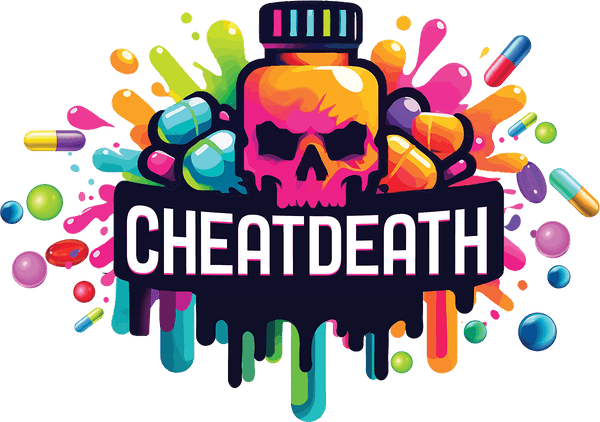Men’s Health
Prostate Formula
Prostate Formula
Couldn't load pickup availability
Includes potent ingredients that also act as antioxidants, like green tea extract and red raspberry. Also included are natural ingredients like uva ursi, pumpkin seed and marshmallow plant. This herbal supplement is a great for a more natural option to supplement one's wellness.*
| Formula Purposes & Benefits |
|
Prostate Formula is formulated to support prostate health, antioxidant activity, energy, cognition, sexual function, mood, and cardiovascular health. Our product is synthesized utilizing the latest scientific research and formulated with high-quality ingredients. Our formula is third-party independently tested for heavy metals, impurities, made in the USA, GMP certified, and produced in an FDA registered facility. 1% of the supplements on the market can match our world-class standards. |
| Formula Ingredient Deck | Benefits Of Each Ingredient |
| Vitamin E |
|
| Vitamin B6 |
|
| Zinc |
|
| Copper |
|
| Selenium |
|
| Saw Palmetto |
|
| Pygeum Africanum |
|
| Red Raspberry |
|
| Graviola |
|
| Green Tea Extract |
|
| Cat’s Claw |
|
| Broccoli Extract |
|
| Tomato Extract/Lycopene |
|
| Stinging Nettle |
|
| Maitake, Reishi, Shitake |
|
| Quercetin |
|
| Juniper |
|
| Uva Ursi |
|
| Buchu |
|
| L-Alanine |
|
| L-Glycine |
|
| Pumpkin Seed |
|
| Cayenne Pepper |
|
| Goldenseal |
|
| Marshmallow |
|
| Parsley |
|
| Proper Use of This Supplement |
| Suggested Use: As a dietary supplement take two (2) veggie capsules once a day. For best results take two 20-30 minutes before a meal with an 8 oz glass of water, or as directed by your health care professional. |
| Our Formula Vs Other Formulas on the Market. | |
| 1. Uses third-party independently tested ingredients that are made in the USA, GMP certified, and made in an FDA registered facility. | 1. Source cheap ingredients from heavily polluted soils. Even “organic” supplements not third-party tested have been removed by FDA due to high levels of heavy metals. |
| 2. Uses high-quality nutraceuticals in an effective evidence-based and efficaciously dosed formula. | 2. Uses cheap sources of nutraceuticals that contain high amounts of fillers, heavy metals, and is formulated without evidence-based dosages. |
Sources
19.Salinas-Casado, J., Esteban-Fuertes, M., Carballido-Rodríguez, J., & Cozar-Olmo, J. M. (2020). Review of the experience and evidence of Pygeum africanum in urological practice. Revisión sobre la experiencia y evidencias del Pygeum africanum en Urología. Actas urologicas espanolas, 44(1), 9–13. https://doi.org/10.1016/j.acuro.2019.08.002
- Lim, S. H., & Choi, C. I. (2021). Potentials of Raspberry Ketone as a Natural Antioxidant. Antioxidants (Basel, Switzerland), 10(3), 482. https://doi.org/10.3390/antiox10030482
- Park K. S. (2010). Raspberry ketone increases both lipolysis and fatty acid oxidation in 3T3-L1 adipocytes. Planta medica, 76(15), 1654–1658. https://doi.org/10.1055/s-0030-1249860
- Rothenberg, D. O., Zhou, C., & Zhang, L. (2018). A Review on the Weight-Loss Effects of Oxidized Tea Polyphenols. Molecules (Basel, Switzerland), 23(5), 1176. https://doi.org/10.3390/molecules23051176
- Bogdanski, P., Suliburska, J., Szulinska, M., Stepien, M., Pupek-Musialik, D., & Jablecka, A. (2012). Green tea extract reduces blood pressure, inflammatory biomarkers, and oxidative stress and improves parameters associated with insulin resistance in obese, hypertensive patients. Nutrition research (New York, N.Y.), 32(6), 421–427. https://doi.org/10.1016/j.nutres.2012.05.007
- Haidari, F., Samadi, M., Mohammadshahi, M., Jalali, M. T., & Engali, K. A. (2017). Energy restriction combined with green coffee bean extract affects serum adipocytokines and the body composition in obese women. Asia Pacific journal of clinical nutrition, 26(6), 1048–1054. https://doi.org/10.6133/apjcn.022017.03
- Ueland, P. M., McCann, A., Midttun, Ø., & Ulvik, A. (2017). Inflammation, vitamin B6 and related pathways. Molecular aspects of medicine, 53, 10–27. https://doi.org/10.1016/j.mam.2016.08.001
- Bird R. P. (2018). The Emerging Role of Vitamin B6 in Inflammation and Carcinogenesis. Advances in food and nutrition research, 83, 151–194. https://doi.org/10.1016/bs.afnr.2017.11.004
- Mascolo, E., & Vernì, F. (2020). Vitamin B6 and Diabetes: Relationship and Molecular Mechanisms. International journal of molecular sciences, 21(10), 3669. https://doi.org/10.3390/ijms21103669
- Chilelli, N. C., Ragazzi, E., Valentini, R., Cosma, C., Ferraresso, S., Lapolla, A., & Sartore, G. (2016). Curcumin and Boswellia serrata Modulate the Glyco-Oxidative Status and Lipo-Oxidation in Master Athletes. Nutrients, 8(11), 745. https://doi.org/10.3390/nu8110745
- Barzegar, A., & Moosavi-Movahedi, A. A. (2011). Intracellular ROS protection efficiency and free radical-scavenging activity of curcumin. PloS one, 6(10), e26012. https://doi.org/10.1371/journal.pone.0026012
- Banik, U., Parasuraman, S., Adhikary, A. K., & Othman, N. H. (2017). Curcumin: the spicy modulator of breast carcinogenesis. Journal of experimental & clinical cancer research : CR, 36(1), 98. https://doi.org/10.1186/s13046-017-0566-5
- Suhett, L. G., de Miranda Monteiro Santos, R., Silveira, B., Leal, A., de Brito, A., de Novaes, J. F., & Lucia, C. (2021). Effects of curcumin supplementation on sport and physical exercise: a systematic review. Critical reviews in food science and nutrition, 61(6), 946–958. https://doi.org/10.1080/10408398.2020.1749025
- Pivari, F., Mingione, A., Brasacchio, C., & Soldati, L. (2019). Curcumin and Type 2 Diabetes Mellitus: Prevention and Treatment. Nutrients, 11(8), 1837. https://doi.org/10.3390/nu11081837
- Ashtary-Larky, D., Rezaei Kelishadi, M., Bagheri, R., Moosavian, S. P., Wong, A., Davoodi, S. H., Khalili, P., Dutheil, F., Suzuki, K., & Asbaghi, O. (2021). The Effects of Nano-Curcumin Supplementation on Risk Factors for Cardiovascular Disease: A GRADE-Assessed Systematic Review and Meta-Analysis of Clinical Trials. Antioxidants (Basel, Switzerland), 10(7), 1015. https://doi.org/10.3390/antiox10071015
- Evron, E., Juhasz, M., Babadjouni, A., & Mesinkovska, N. A. (2020). Natural Hair Supplement: Friend or Foe? Saw Palmetto, a Systematic Review in Alopecia. Skin appendage disorders, 6(6), 329–337. https://doi.org/10.1159/000509905
- Kwon Y. (2019). Use of saw palmetto (Serenoa repens) extract for benign prostatic hyperplasia. Food science and biotechnology, 28(6), 1599–1606. https://doi.org/10.1007/s10068-019-00605-9
- Gombart, A. F., Pierre, A., & Maggini, S. (2020). A Review of Micronutrients and the Immune System-Working in Harmony to Reduce the Risk of Infection. Nutrients, 12(1), 236. https://doi.org/10.3390/nu12010236
- Heffernan, S. M., Horner, K., De Vito, G., & Conway, G. E. (2019). The Role of Mineral and Trace Element Supplementation in Exercise and Athletic Performance: A Systematic Review. Nutrients, 11(3), 696. https://doi.org/10.3390/nu11030696
- Wang, N., Tan, H. Y., Li, S., Xu, Y., Guo, W., & Feng, Y. (2017). Supplementation of Micronutrient Selenium in Metabolic Diseases: Its Role as an Antioxidant. Oxidative medicine and cellular longevity, 2017, 7478523. https://doi.org/10.1155/2017/7478523
- Wichman, J., Winther, K. H., Bonnema, S. J., & Hegedüs, L. (2016). Selenium Supplementation Significantly Reduces Thyroid Autoantibody Levels in Patients with Chronic Autoimmune Thyroiditis: A Systematic Review and Meta-Analysis. Thyroid : official journal of the American Thyroid Association, 26(12), 1681–1692. https://doi.org/10.1089/thy.2016.0256
147.Benstoem, C., Goetzenich, A., Kraemer, S., Borosch, S., Manzanares, W., Hardy, G., & Stoppe, C. (2015). Selenium and its supplementation in cardiovascular disease--what do we know?. Nutrients, 7(5), 3094–3118. https://doi.org/10.3390/nu7053094
- Maywald, M., Wessels, I., & Rink, L. (2017). Zinc Signals and Immunity. International journal of molecular sciences, 18(10), 2222. https://doi.org/10.3390/ijms18102222
- Wessels, I., Rolles, B., & Rink, L. (2020). The Potential Impact of Zinc Supplementation on COVID-19 Pathogenesis. Frontiers in immunology, 11, 1712. https://doi.org/10.3389/fimmu.2020.01712
- Vahlensieck, W., Theurer, C., Pfitzer, E., Patz, B., Banik, N., & Engelmann, U. (2015). Effects of pumpkin seed in men with lower urinary tract symptoms due to benign prostatic hyperplasia in the one-year, randomized, placebo-controlled GRANU study. Urologia internationalis, 94(3), 286–295. https://doi.org/10.1159/000362903
- Hsu, Y. J., Huang, W. C., Chiu, C. C., Liu, Y. L., Chiu, W. C., Chiu, C. H., Chiu, Y. S., & Huang, C. C. (2016). Capsaicin Supplementation Reduces Physical Fatigue and Improves Exercise Performance in Mice. Nutrients, 8(10), 648. https://doi.org/10.3390/nu8100648
- Eichner E. R. (2016). Fighting Muscle Cramps With Two Spices and One Hot Fruit. Current sports medicine reports, 15(5), 304–305. https://doi.org/10.1249/JSR.0000000000000298
- Ziaei R, Foshati S, Hadi A, Kermani MAH, Ghavami A, Clark CCT, Tarrahi MJ. The effect of nettle (Urtica dioica) supplementation on the glycemic control of patients with type 2 diabetes mellitus: A systematic review and meta-analysis. Phytother Res. 2020 Feb;34(2):282-294. doi: 10.1002/ptr.6535. Epub 2019 Dec 4. PMID: 31802554.
- Chen, P., Zhang, W., Wang, X., Zhao, K., Negi, D. S., Zhuo, L., Qi, M., Wang, X., & Zhang, X. (2015). Lycopene and Risk of Prostate Cancer: A Systematic Review and Meta-Analysis. Medicine, 94(33), e1260. https://doi.org/10.1097/MD.0000000000001260
- Beynon, R. A., Richmond, R. C., Santos Ferreira, D. L., Ness, A. R., May, M., Smith, G. D., Vincent, E. E., Adams, C., Ala-Korpela, M., Würtz, P., Soidinsalo, S., Metcalfe, C., Donovan, J. L., Lane, A. J., Martin, R. M., ProtecT Study Group, & PRACTICAL consortium (2019). Investigating the effects of lycopene and green tea on the metabolome of men at risk of prostate cancer: The ProDiet randomised controlled trial. International journal of cancer, 144(8), 1918–1928. https://doi.org/10.1002/ijc.31929
- Shanbhag V. K. (2016). Lycopene in cancer therapy. Journal of pharmacy & bioallied sciences, 8(2), 170–171. https://doi.org/10.4103/0975-7406.171740
- Hetland G, Tangen JM, Mahmood F, Mirlashari MR, Nissen-Meyer LSH, Nentwich I, Therkelsen SP, Tjønnfjord GE, Johnson E. Antitumor, Anti-Inflammatory and Antiallergic Effects of Agaricus blazei Mushroom Extract and the Related Medicinal Basidiomycetes Mushrooms, Hericium erinaceus and Grifolafrondosa: A Review of Preclinical and Clinical Studies. Nutrients. 2020 May 8;12(5):1339. doi: 10.3390/nu12051339. PMID: 32397163; PMCID: PMC7285126.
- Mallard B, Leach DN, Wohlmuth H, Tiralongo J. Synergistic immuno-modulatory activity in human macrophages of a medicinal mushroom formulation consisting of Reishi, Shiitake and Maitake. PLoS One. 2019 Nov 7;14(11):e0224740. doi: 10.1371/journal.pone.0224740. PMID: 31697749; PMCID: PMC6837746.
- Afshar K, Fleischmann N, Schmiemann G, Bleidorn J, Hummers-Pradier E, Friede T, Wegscheider K, Moore M, Gágyor I. Reducing antibiotic use for uncomplicated urinary tract infection in general practice by treatment with uva-ursi (REGATTA) - a double-blind, randomized, controlled comparative effectiveness trial. BMC Complement Altern Med. 2018 Jul 3;18(1):203. doi: 10.1186/s12906-018-2266-x. PMID: 29970072; PMCID: PMC6029138.
- Dandare SU, Ezeonwumelu IJ, Shinkafi TS, Magaji UF, Adio AA, Ahmad K. L-alanine supplementation improves blood glucose level and biochemical indices in alloxan-induced diabetic rats. J Food Biochem. 2021 Jan;45(1):e13590. doi: 10.1111/jfbc.13590. Epub 2020 Dec 21. PMID: 33346923.
- Sekhar, R. V., Patel, S. G., Guthikonda, A. P., Reid, M., Balasubramanyam, A., Taffet, G. E., & Jahoor, F. (2011). Deficient synthesis of glutathione underlies oxidative stress in aging and can be corrected by dietary cysteine and glycine supplementation. The American journal of clinical nutrition, 94(3), 847–853. https://doi.org/10.3945/ajcn.110.003483
- Razak, M. A., Begum, P. S., Viswanath, B., & Rajagopal, S. (2017). Multifarious Beneficial Effect of Nonessential Amino Acid, Glycine: A Review. Oxidative medicine and cellular longevity, 2017, 1716701. https://doi.org/10.1155/2017/1716701
- Bonaterra GA, Bronischewski K, Hunold P, Schwarzbach H, Heinrich EU, Fink C, Aziz-Kalbhenn H, Müller J, Kinscherf R. Anti-inflammatory and Anti-oxidative Effects of Phytohustil® and Root Extract of Althaea officinalis L. on Macrophages in vitro. Front Pharmacol. 2020 Mar 17;11:290. doi: 10.3389/fphar.2020.00290. PMID: 32256361; PMCID: PMC7090173.
- Goldenseal. (2021). In Drugs and Lactation Database (LactMed). National Library of Medicine (US).
- Mandal, S. K., Maji, A. K., Mishra, S. K., Ishfaq, P. M., Devkota, H. P., Silva, A. S., & Das, N. (2020). Goldenseal (Hydrastis canadensis L.) and its active constituents: A critical review of their efficacy and toxicological issues. Pharmacological research, 160, 105085. https://doi.org/10.1016/j.phrs.2020.105085
- Mara de Menezes Epifanio, N., Rykiel Iglesias Cavalcanti, L., Falcão Dos Santos, K., Soares Coutinho Duarte, P., Kachlicki, P., Ożarowski, M., Jorge Riger, C., & Siqueira de Almeida Chaves, D. (2020). Chemical characterization and in vivo antioxidant activity of parsley (Petroselinum crispum) aqueous extract. Food & function, 11(6), 5346–5356. https://doi.org/10.1039/d0fo00484g
- Jovic, T. H., Ali, S. R., Ibrahim, N., Jessop, Z. M., Tarassoli, S. P., Dobbs, T. D., Holford, P., Thornton, C. A., & Whitaker, I. S. (2020). Could Vitamins Help in the Fight Against COVID-19?. Nutrients, 12(9), 2550. https://doi.org/10.3390/nu12092550
- Traber, M. G., & Atkinson, J. (2007). Vitamin E, antioxidant and nothing more. Free radical biology & medicine, 43(1), 4–15. https://doi.org/10.1016/j.freeradbiomed.2007.03.024
- Wu, D., & Meydani, S. N. (2014). Age-associated changes in immune function: impact of vitamin E intervention and the underlying mechanisms. Endocrine, metabolic & immune disorders drug targets, 14(4), 283–289. https://doi.org/10.2174/1871530314666140922143950
- De la Fuente, M., Hernanz, A., Guayerbas, N., Victor, V. M., & Arnalich, F. (2008). Vitamin E ingestion improves several immune functions in elderly men and women. Free radical research, 42(3), 272–280. https://doi.org/10.1080/10715760801898838
- Browne, D., McGuinness, B., Woodside, J. V., & McKay, G. J. (2019). Vitamin E and Alzheimer's disease: what do we know so far?. Clinical interventions in aging, 14, 1303–1317. https://doi.org/10.2147/CIA.S186760
Serving Size: 2 Capsules;
Capsules Per Container: 60;
Bottle Color: White;
Bottle Size: 175cc;
Lid Color: White

* These statements have not been evaluated by the Food and Drug Administration. This product is not intended to diagnose, treat, cure or prevent any disease.
Share




